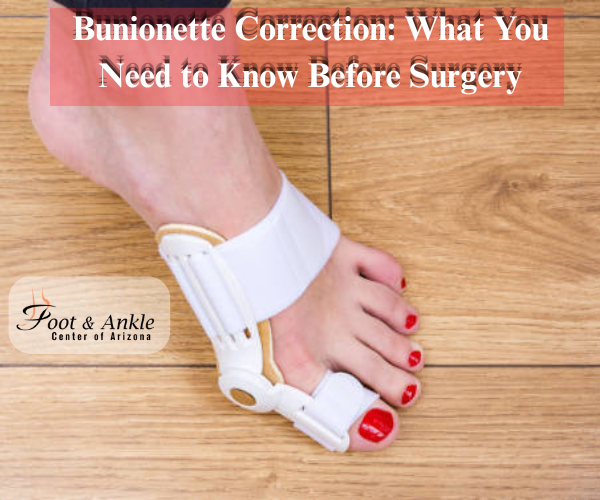
A small bump on the outside of your foot can cause big problems. It may hurt when you walk or wear shoes. That bump may be a bunionette. Some people call it a Tailor’s Bunion.
At the Foot and Ankle Center of Arizona, we help people with foot pain every day. Our doctor, Kris A. DiNucci, is a trained Podiatric Foot and Ankle Surgeon. He works with patients to help them feel better and walk without pain.
Let’s learn more about bunionette correction and what you should know before having surgery.
What Is a Bunionette?
A bunionette is a bump on the outside of your foot. It sits near the base of your little toe. It can form when the bones in your foot move out of place.
This bump can rub on your shoe. That can cause pain, redness, or swelling. Some people also feel burning or tightness in the area.
There are many reasons bunionettes form:
- Tight shoes
- Flat feet
- Bone shape from birth
- Injury or arthritis
If you have pain that won’t go away, it’s time to see a doctor.
When Do You Need Bunionette Correction?
Some people feel better with simple care. You can try:
- Wearing wider shoes
- Using padding or shoe inserts
- Taking medicine like ibuprofen
- Icing the foot
But if the pain doesn’t go away, surgery might help. This is called bunionette correction. The goal is to fix the bone and stop the pain.
What Happens During Surgery?
Dr. Kris A. DiNucci will talk to you before the surgery. He will take X-rays to look at your foot bones.
Here’s what the surgery may include:
- Making a small cut on the side of the foot
- Moving or shaving the bone
- Fixing the bone with a small screw or pin
- Closing the cut with stitches
It usually takes less than an hour. You may go home the same day.
Most people do not feel pain during the surgery. That’s because the doctor gives medicine to help you sleep or numb your foot.
What Is Recovery Like?
After the surgery, your foot needs time to heal. Here’s what you can expect:
- You may wear a special boot or shoe
- Keep your foot raised to stop swelling
- Do not walk much for the first few days
- You may need crutches or a walker
Most people can walk better in 6 to 8 weeks. Full healing may take 3 months.
Is Bunionette Correction Safe?
Yes, bunionette correction is safe for most people. But like all surgery, there can be risks:
- Infection
- Swelling
- Nerve pain
- Bone not healing right
Dr. DiNucci will talk to you about these risks. He will help you make a good plan. Our goal is to keep you safe and pain-free.
How to Prepare for Surgery
Before your surgery, the team at the Foot and Ankle Center of Arizona will give you steps to follow:
- Stop certain medicines if needed
- Arrange a ride home
- Have someone help you for a few days
- Get a comfy place to rest your foot
Follow all the steps to help your foot heal faster.
Why Choose Our Office?
At the Foot and Ankle Center of Arizona, we care about your health. Dr. Kris A. DiNucci is skilled and friendly. Our team listens and helps you feel at ease.
We’re located in sunny Scottsdale, AZ. Our office is easy to reach. We’ll answer your questions and help you feel safe and cared for.
FAQs
Is bunionette correction painful?
Most people feel little pain during the surgery. Afterward, some soreness is normal. Medicine can help.
How long before I can walk again?
Many people walk with help in 2 weeks. Full healing may take up to 12 weeks.
Can a bunionette come back after surgery?
With good care and proper shoes, it’s rare. But it can happen in some cases.
Conclusion
A bunionette may be small, but it can cause big pain. Surgery is one way to fix the problem and feel better again. At the Foot and Ankle Center of Arizona, we are ready to help you every step of the way.
Dr. Kris A. DiNucci and our caring team want you to walk with comfort. We make it easy to understand your care and treatment options.
Contact us today to schedule your visit or ask a question. You can reach us on our website’s Contact Us or Request an Appointment page. Let us help your feet feel better again!